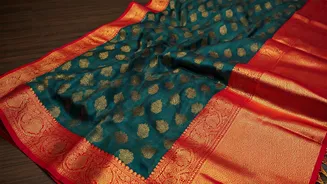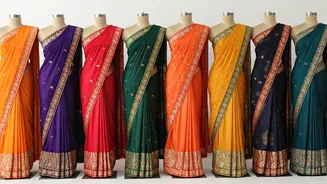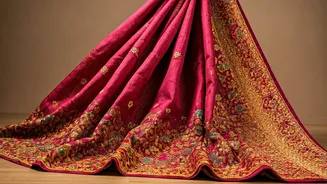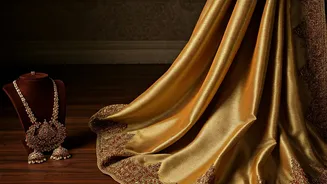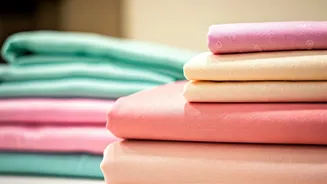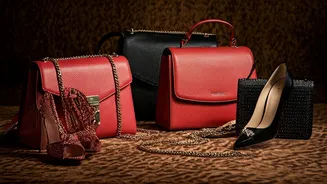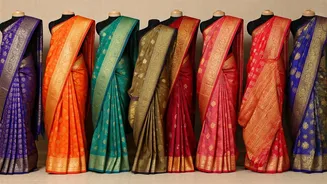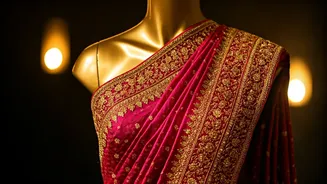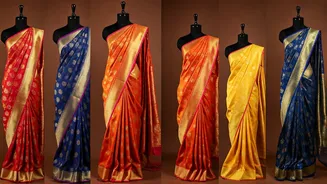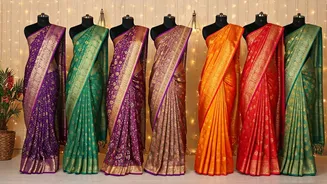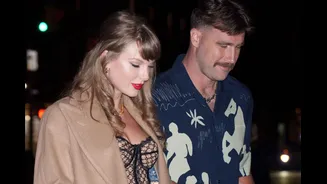Sarees: A Cultural Icon
The saree, a traditional Indian garment, transcends mere clothing; it signifies cultural identity and elegance, especially within the context of Bollywood.
Actresses wearing sarees have consistently set fashion trends, becoming synonymous with grace and poise. The saree's versatility allows for endless design variations, making it a favorite for both on-screen characters and real-life appearances. Its vibrant colors, intricate patterns, and diverse draping styles showcase India's rich heritage and artistic skills. Bollywood stars often use sarees to make a statement, whether at film promotions, award ceremonies, or personal events, reinforcing the saree's position as an enduring symbol of Indian culture and femininity. The saree's appeal extends beyond India, capturing global attention and influencing fashion trends worldwide. It is a timeless garment that continues to evolve, adapting to modern aesthetics while preserving its traditional essence.
Iconic Saree Moments
Several Bollywood actresses have created unforgettable saree moments that have resonated with audiences across generations. These moments aren't just about the outfits themselves; they are about the complete look – the actress, the drape, the accessories, and the setting. For instance, the sheer chiffon sarees often worn in romantic scenes have become a hallmark of Bollywood. Actresses such as Rekha, with her signature Kanjeevaram sarees, have made this style unforgettable. Madhuri Dixit's elegant sarees in various dance sequences have also left an indelible mark. Furthermore, Aishwarya Rai Bachchan, known for her graceful presence, has frequently graced the red carpet and other events in exquisite sarees, representing a blend of tradition and modernity. Each saree appearance contributes to the actresses' image and enhances the saree's appeal, shaping cultural perceptions of elegance and fashion. These moments remind us of the saree's timeless adaptability and its ability to reflect the diverse tastes and preferences of both the film industry and society at large.
Saree Fashion Evolution
The evolution of the saree in Bollywood reflects the changing times and fashion sensibilities. Earlier, traditional styles like Banarasi and Kanjeevaram sarees dominated film appearances, showcasing classic Indian craftsmanship. As Bollywood evolved, so did the saree styles, incorporating contemporary designs and experimental drapes. Designers started to blend traditional weaves with modern cuts, introducing elements like sequins, embroidery, and innovative blouse designs. The introduction of lighter fabrics such as chiffon and georgette made sarees more wearable and stylish. The influence of modern designers is apparent in the saree trends, creating looks that are bold and fresh. This evolution also shows a shift toward embracing different regional styles, reflecting India's diversity. This dynamic adaptation ensures the saree remains relevant. It constantly reinvents itself to appeal to new audiences while preserving its timeless appeal.
Sarees: Beyond Bollywood
The saree's influence extends far beyond the confines of Bollywood. It has profoundly impacted the fashion industry and continues to inspire designers worldwide. Indian designers frequently showcase sarees at international fashion weeks, promoting Indian textiles and craftsmanship globally. The saree has also gained international recognition, with celebrities from different cultures often sporting this elegant garment. Its versatility allows for various adaptations, from formal evening wear to casual everyday attire. The saree's presence in international fashion indicates a growing appreciation for Indian culture and aesthetics. It serves as a symbol of cultural exchange, with its popularity enhancing the image of Indian fashion and textiles. The saree's enduring appeal lies in its ability to adapt and be styled for diverse occasions and cultures, making it a globally recognized fashion icon.
